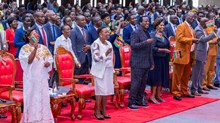(RNS) For the first time, the federal government has issued written guidelines for houses of worship that are confronted with a homicidal gunman.
Vice President Joe Biden released the new rules on yesterday (June 18), six months after the school shooting in Newtown, Connecticut, that left 26 dead, including 20 children. As federal officials worked with education officials in crafting new school safety rules, they also consulted clergy, Biden told a White House auditorium filled with federal officials who have worked on the issue.
"The faith leaders not only want us to talk about making schools safer," Biden said. "They're worried that their congregations are at risk. So they wanted to know, what should they be thinking about when someone stands up in the middle of the congregation and decides to do something similar as we saw in the schools."
In response to their concerns, Biden said, "we gave concrete direction."
Beyond seeking shelter and waiting for police to arrive, as many Newtown victims did, the new rules also advise adults in congregations to fight back–as a last resort–in a bid to stop the shooter. The new federal doctrine is "run, hide, or fight."
The guidelines' basic run-hide-fight advice is similar to that given to schools faced with active shooters: Congregants should first try to flee the scene, taking people with them but not waiting for those who refuse to leave. If flight is not possible, hide; the guidelines describe some of the best hiding places. Fighting back is a last resort.
According to the new rules, gathered in a 38-page document called "Guide for Developing High-Quality Emergency Operations Plans for Houses of Worship," fighting back is advised for "adults in immediate danger," who should:
"Consider trying to disrupt or incapacitate the shooter by using aggressive force and items in their environment, such as fire extinguishers or chairs. In a study of 41 active shooter events that ended before law enforcement arrived, the potential victims stopped the attacker themselves in 16 instances. In 13 of those cases, they physically subdued the attacker."
The question of how best to subdue a gunman is likely to rekindle a debate within many churches, particularly in parts of the country where it is common to carry weapons: Should congregants bring guns to church?
"Each house of worship should determine, as part of its planning process, policies on the control and presence of weapons, as permitted by law," the guidelines say.
Shootings at churches and other houses of worship remain relatively rare, though CT reported in 2009 that incidents have skyrocketed in recent years. Deaths from church attacks rose 36 percent in 2012, prompting many pastors to re-evaluate the security of their churches.
Gunmen–particularly disturbed individuals–may see churches as inviting targets if they are are looking for a highly visible way to settle a grudge or make a political statement.
Last year a gunman killed six people inside a Sikh temple in Oak Creek, Wis. In 2008, a gunman killed two congregants inside a Unitarian church in Knoxville, Tenn. In 2007, a gunman killed two people inside the New Life megachurch in Colorado Springs, Colo., before being shot and killed by an armed volunteer.

Support Our Work
Subscribe to CT for less than $4.25/month


















